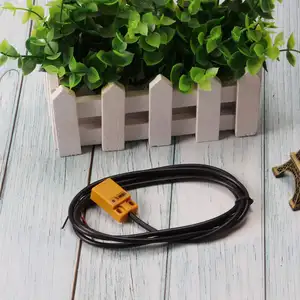
BOJKE Background Suppression Diffused Reflector Accuracy Miniature Photoelectric Sensors Outputs Photoelectric Switch Sensor


Series Wires Pnp Nc E2b Inductive E2k Capacitive Inductive 3 8mm Npn Proximity Sensors Switch Part Number Distance























A photoelectric switch, also known as a photoelectric proximity switch or a photoelectric switch sensor, is a versatile appliance utilized across diverse industries for enhancing operational efficiency and automating systems. Its function is to detect the absence or presence of an object utilizing a visible or infrared light beam.
Photoelectric switches work on a simple principle. They utilize a light transmitter and a receiver to detect objects. The transmitter emits light beams. When an object interrupts the light beam, the receiver will detect the change. The detection will trigger a corresponding process, such as turning on a light or stopping the machine. The working principle of photoelectric switches is well-known for its non-contact feature, as it can reduce wear and tear and offer detection for a wide range of materials, including opaque, translucent, and transparent objects.
Photoelectric switches can be divided into outdoor photoelectric switches and indoor photocell light switches. Typically, there are three main sorts of photoelectric switches. The first type is the diffused photoelectric switch, also known as optical proximity sensing. The receiver and the light source are stored in the same device. Diffuse photoelectric switches detect objects when the light beam is emitted to the target and will be reflected to the switch by the target itself. They are more compact than other typical units because all parts are housed in a single place. Through-beam photoelectric switches, also named opposed modes, usually utilize two separate devices to make and break the light beam. To use them, users should place the object between the transmitter and the receiver. The object will interrupt the light beam and change the amount of light that falls on the receiver. Through-beam photoelectric switches are more accurate and have longer sensing range than their counterparts. Retro-reflective photoelectric switches work in tandem with a reflector. They are good at detecting large objects and those moving at high speeds. They are more cost-effective and just slightly less accurate than through-beam photoelectric switches.
Here are some areas that usually utilize photoelectric switches. The food and beverage industry will use them in packaging or manufacturing lines to make sure things like bottle caps are placed correctly in the proper place. The automotive industry also utilizes photoelectric switches to help with their work. Each component of an automobile needs to stop in front of the relevant station with proper timing when they travel down the production line, so photoelectric switches are used to detect when the station is near. Some automatic doors or gates on elevators, garages, or trains also need photoelectric switches to make sure they can open and close at the right times. Photoelectric switches can detect approaching vehicles or people when necessary.